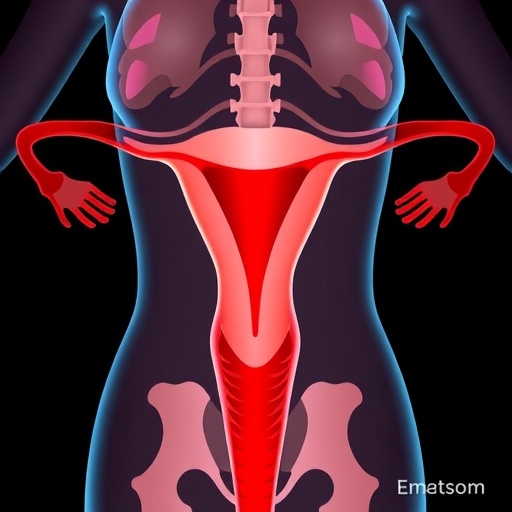In an unprecedented case study, the surgical management of a large polypoid cervical endometriosis in an adolescent girl has drawn significant attention from the medical community. The intricate operation, meticulously documented by Dr. D. Abdelhalim, showcases a novel approach termed transhymenal vaginoscopic resection. This technique not only emphasizes surgical innovation but also highlights a growing trend in minimally invasive gynecological procedures, which aim to reduce patient recovery time while maintaining surgical efficacy.
Endometriosis, a condition where tissue similar to the lining inside the uterus, known as the endometrium, grows outside of it, can manifest in various challenging forms. The appearance of cervical endometriosis is particularly rare and poses unique challenges, especially in young patients who may present with both physical and psychological ramifications of their condition. In this case, the young patient exhibited significant symptoms that directly impacted her quality of life and well-being, necessitating a thorough evaluation and an urgent surgical intervention.
Traditional surgical methods for addressing cervical endometriosis often involve extensive procedures that can lead to prolonged recovery periods, increased hospital stays, and higher risks of complications. In contrast, the transhymenal vaginoscopic approach utilized by Dr. Abdelhalim seeks to circumvent these issues by providing direct access to the cervical region through the vaginal canal. This method not only minimizes external scarring but also reduces the overall trauma to the pelvic area, thereby enhancing recovery outcomes for the adolescent patient.
During the surgical procedure, Dr. Abdelhalim demonstrated a high level of precision and skill. The vaginoscopic technique allows surgeons to visualize the surgical site in real-time, facilitating accurate identification and resection of the endometriotic tissue. This is particularly crucial when dealing with its polypoid forms, which may be more challenging to excise using conventional approaches. The positive outcomes of this case underscore the importance of continual advancements in surgical methodologies, especially those that advocate for less invasive approaches.
Post-operative assessments revealed a notable improvement in the patient’s symptoms, which had been severely debilitating prior to the surgery. This dramatic alleviation of discomfort and pain reinstated hope in the patient and her family, reinforcing the vital role that innovative surgical techniques can play in treating gynecological ailments. The case highlights the necessity for ongoing research into effective management strategies for conditions like endometriosis that disproportionately affect young women.
Dr. Abdelhalim’s research does not merely stop at the clinical outcomes. The detailed exploration of existing literature surrounding cervical endometriosis reveals a significant gap in understanding and addressing this condition in adolescents. The literature review serves as a vital contribution to this field, providing insights into existing treatment paradigms while advocating for broader awareness and further research into adolescent endometriosis. By sharing the findings, Dr. Abdelhalim aims to inspire gynecologists and surgeons worldwide to consider similar innovative approaches when treating young patients.
Furthermore, the complexities involved in diagnosing and treating endometriosis in adolescents often extend beyond physical symptoms. Mental health considerations play a critical role, as young individuals may experience significant emotional distress due to chronic pain and the implications of their condition on lifestyle and fertility. The case study is a timely reminder of the holistic approach required in treating such multifaceted health issues, where psychological support and counseling are equally as important as surgical interventions.
The case of the adolescent girl has ignited a conversation within the medical community about the importance of individualized care. Every patient is unique, necessitating tailored interventions that consider a multitude of factors — from the physical presentation of endometriosis to the personal and emotional context of the patient. As healthcare providers, there is an ethical obligation to ensure that treatments are not only effective but also sensitive to the needs and challenges faced by the patients we serve.
In light of this groundbreaking work, there is hope that healthcare policies will evolve to better accommodate the needs of young women with endometriosis. Increased funding for research and clinical trials embracing less invasive techniques could provide critical support for developing guidelines that advocate for the adoption of procedures like transhymenal vaginoscopic resection. The integration of technological advancements in gynecological surgeries can pave the way for better outcomes and enhanced quality of care for this vulnerable population.
In conclusion, the case presented by Dr. Abdelhalim marks a significant step forward in the management of cervical endometriosis through innovative surgical techniques. By highlighting the importance of tailored surgical approaches, comprehensive care, and ongoing research, we envision a future where adolescent patients receive the best possible outcomes. This study not only sheds light on the clinical aspects of cervical endometriosis but also serves as a rallying call for greater awareness and proactive care in addressing this complex condition.
As we look towards future developments in gynecological practice, the pioneering work encapsulated in this case presents an opportunity for advancements that could reshape traditional protocols, improve patient experiences, and ultimately lead to a deeper understanding of endometriosis as it affects young women around the world.
Subject of Research: Endometriosis in Adolescents
Article Title: Transhymenal Vaginoscopic Resection of a Large Polypoid Cervical Endometriosis in an Adolescent Girl: Case Report and Literature Review
Article References:
Abdelhalim, D. Transhymenal Vaginoscopic Resection of a Large Polypoid Cervical Endometriosis in an Adolescent Girl: Case Report and Literature Review. Reprod. Sci. (2025). https://doi.org/10.1007/s43032-025-01934-3
Image Credits: AI Generated
DOI: 10.1007/s43032-025-01934-3
Keywords: Cervical Endometriosis, Transhymenal Resection, Adolescents, Surgical Techniques, Minimally Invasive Surgery.




